Kaziranga National Park is located in Assam, India, and is a UNESCO World Heritage Site. The park is known for its diverse flora and fauna, with over 480 species of birds and over 2,000 Indian one-horned rhinoceroses, which is the highest concentration of rhinos found in the world. The park covers an area of 430 square kilometers and is divided into four ranges, each with its unique vegetation.
The visit to Kaziranga National Park in Assam, is an unforgettable experience for nature lovers and wildlife enthusiasts. The park’s vegetation is mostly made up of tall elephant grass interspersed with patches of evergreen forest. The main attraction of the Kaziranga National Park in Assam is the Indian one-horned rhinoceros, along with several other species of mammals such as elephants, tigers, and wild water buffalos. The jungle safaris in Kaziranga are also interesting and fun.
In addition to its diverse wildlife, the park also offers breathtaking views of the Brahmaputra River and the Himalayan Mountains. Visitors can take a Jeep safari or an elephant ride to explore the park and get up close and personal with the wildlife.
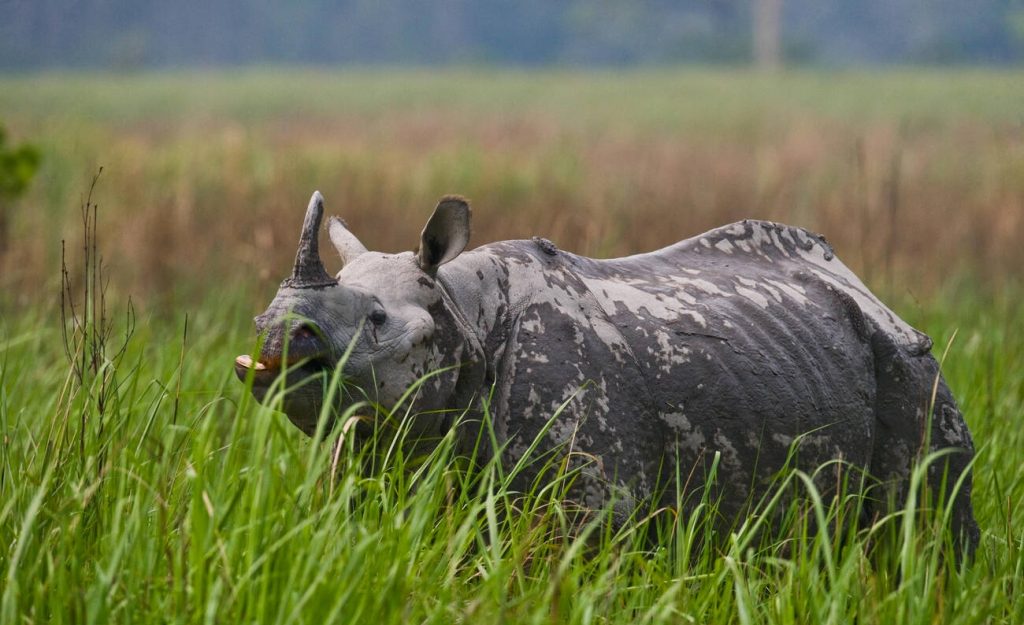
Why is kaziranga national park famous for?
Kaziranga National Park in Assam is also home to several other attractions, including the historical Panbari Reserve Forest, the Burapahar Range, and the Agaratoli Range. The Burapahar Range is known for its scenic beauty, with rolling hills and dense forests, while the Agaratoli Range is known for its beautiful tea gardens.
Kaziranga National Park in Assam is a must-visit destination for those who love nature and wildlife. With its diverse flora and fauna, breathtaking views, and exciting activities, a visit to Kaziranga is sure to leave you with memories that will last a lifetime.
As the park is widely known for its large population of Indian one-horned rhinoceroses, it is therefore referred “rhinoceros’ home of India”. With its rolling hills, lush green grasslands, and diverse range of flora and fauna, Kaziranga National Park in Assam is a nature lover’s paradise. Visitors from all over the world come here to admire its stunning beauty and get a chance to see the rare and magnificent rhinoceroses in their natural habitat. Additionally, Kaziranga National Park in Assam also offers a range of activities, such as elephant and jeep safaris, bird-watching, and cultural tours, making it a must-visit destination for anyone who wants to experience the wild and diverse beauty of India.
The history of Kaziranga National Park in Assam can be traced back to the early 20th century when the park was established as a reserve forest in 1905. Over the years, it has undergone several expansions and changes in its status, finally being declared a national park in 1974. Today, Kaziranga covers an area of 430 square kilometers and is home to a variety of species, including elephants, tigers, and various species of deer and birds.
Another popular attraction in Kaziranga is the Elephant Festival, which takes place annually in January and February. During this festival, elephants are decorated and paraded through the park, accompanied by traditional music and dance performances. This is a great opportunity for visitors to see these magnificent animals up close and to learn about the cultural significance of elephants in India.
In addition to its rich wildlife, Kaziranga is also known for its scenic beauty and the Brahmaputra River, which runs through the park and provides a habitat for numerous species of fish and waterfowl. Visitors can also explore the park’s numerous trekking trails, which offer stunning views of the surrounding landscape and a chance to see wildlife in their natural habitats.
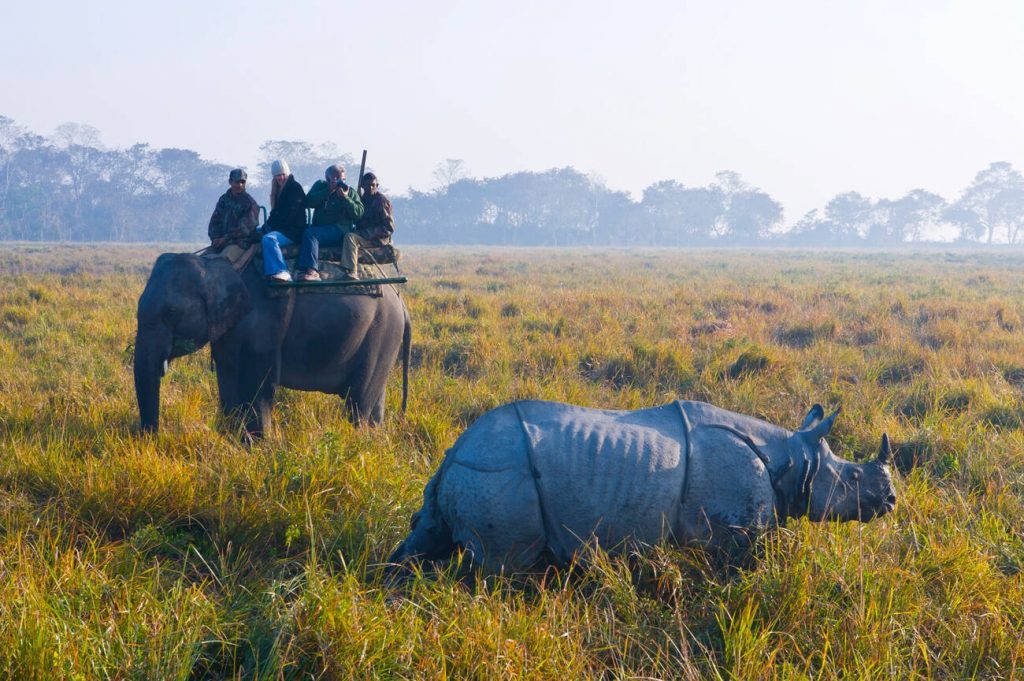
Ranges In Kaziranga National Park
Kaziranga National Park is divided into 4 main Zones (Ranges).
The Central Range or Kohora Range – Kaziranga National Park:
The Central Range, also known as the Kohora Range, is a prominent area of interest within Kaziranga National Park, drawing tourists to its expansive and diverse forests. This zone serves as one of the primary points of entry for visitors, with the main entrance gate to the Kohora/Central zone located just around 2 kilometers from the National Highway, passing through the market and village of Kohora.
The Central Zone is positioned along the southern riverbed of the Brahmaputra River, offering a rich tapestry of wildlife and landscapes. The region is characterized by wetlands, water bodies, and elevated areas adorned with lush greenery, making it an ideal habitat for a variety of avifauna, particularly renowned for birdwatching.
Visitors to the Kohora Range can witness the majestic Indian One-Horned Rhinoceros of Kaziranga, often seen grazing in the vast grasslands. You may also encounter herds of wild elephants, ranging from adorable baby elephants to majestic old elephants, and a multitude of other captivating wildlife and flora found within Kaziranga National Park.
The Western Range or Bagori Range – Kaziranga National Park:
The Kohora Range, situated in the heart of Kaziranga National Park, is a prominent destination for tourists seeking to explore the vast and enchanting forests of the region. This zone serves as one of the primary entry points, with the main gate to the Kohora/Central zone conveniently located just approximately 2 kilometers from the National Highway, passing through the bustling market and charming village of Kohora.
The Kohora Range encompasses the southern riverbed of the mighty Brahmaputra River, offering a rich tapestry of wildlife and diverse landscapes. Its wetlands, water bodies, and elevated terrains adorned with lush greenery create an ideal habitat for avifauna, making it a premier spot for bird enthusiasts.
At the Kohora Range, visitors have the opportunity to witness the magnificent Indian One-Horned Rhinoceros of Kaziranga, often found grazing or wallowing in the expansive grasslands. It’s also possible to spot herds of wild elephants, from endearing baby elephants to majestic elder members, along with a wide array of other captivating wildlife and flora that call Kaziranga National Park home.
The Eastern Zone of Agoratoli Range – Kaziranga National Park:
The Agaratoli Range is the final leg of your journey through Kaziranga National Park when driving from Guwahati. If you’ve yet to have your fill of Indian One-Horned Rhinoceros sightings in the Central and Western Ranges and aspire to witness the elusive Tigers of Kaziranga in their natural habitat, the Agaratoli Range is your prime destination.
Nestled in the eastern part of the park, near the Agartoli village along the National Highway, the Agaratoli Safari Zone is renowned for its unspoiled natural beauty and abundant wildlife, making it a paradise for wildlife photographers. This region also hosts a wide array of bird species native to Kaziranga.
The Agaratoli Safari Range is particularly known for its large herds of elephants. With its tall grasslands and sandy banks along the Brahmaputra, it’s considered Bengal Florican country. Lucky visitors may even witness the rare and endangered Bengal Florican’s mating display in this area.
Notably, the Agaratoli Zone of Kaziranga National Park offers exclusively Jeep safaris, as elephant safaris are not available. This zone, less frequented by tourists, is a favorite among wildlife photography enthusiasts.
The Burapahar zone – Kaziranga National Park:
The Burapahar Zone in Kaziranga National Park marks the initial leg of your journey when traveling from Guwahati by road. Situated approximately 40 kilometers from the central Kohora range of Kaziranga National Park, this zone boasts a distinct entry gate located in the village of Ghorakati, right alongside the Assam National Highway.
Burapahar’s terrain is characterized by its hilly landscapes and dense greenery, making it a haven for wildlife enthusiasts. Notably, this zone is a prime location for spotting the Hoolock Gibbon and the Capped Langur, two remarkable primate species. Additionally, a diverse range of avifauna species call this zone home, providing ample opportunities for birdwatching.
Top Attractions of Kaziranga (One Horned Rhinoceros) –
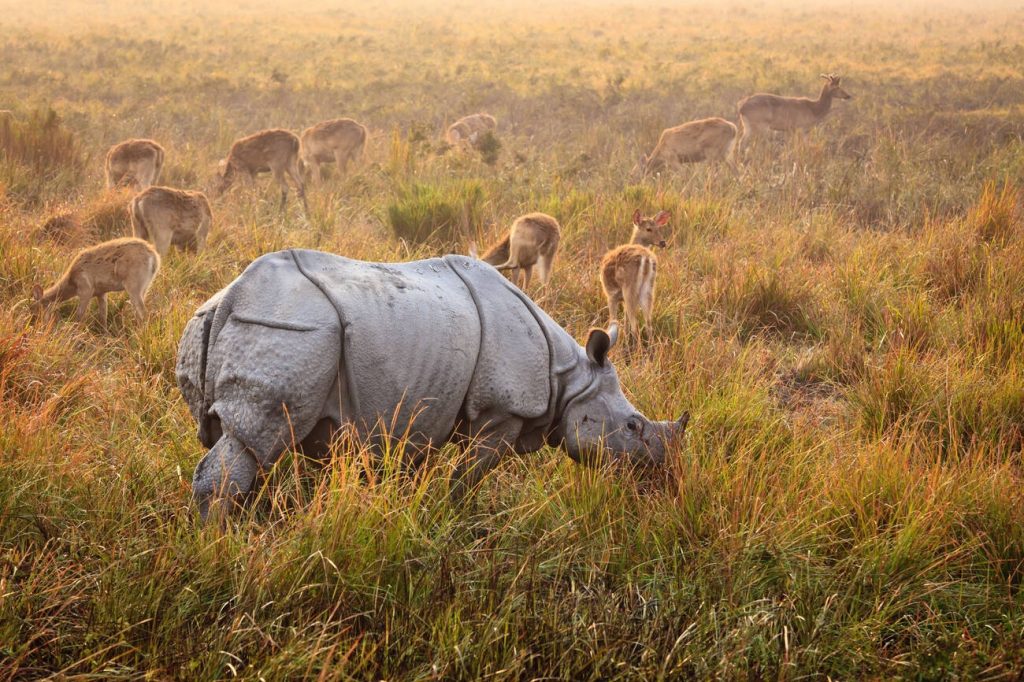
- One of the biggest Kaziranga attraction is its one-horned rhinoceros population, which is the largest in the world. These majestic animals can be seen in their natural habitat during a safari in the park, either by jeep or by an elephant. An elephant safari offers a unique and exciting experience, as visitors can get up close and personal with the rhinos while enjoying the breathtaking scenery. In addition to the one-horned rhinos, Kaziranga is also home to other fascinating wildlife, including the rock python, king cobra, and a variety of bird species. The park is a popular destination for bird watchers and photographers, as it offers ample opportunities to capture the beauty of its avian inhabitants.
- The Orchid Park in Kaziranga is a must-visit for nature lovers and botanists, as it is home to a wide variety of orchids, including some that are indigenous to the area. The park showcases the beauty and diversity of orchids, and visitors can learn about their unique characteristics and habitats.
- The tribal village in Kaziranga provides visitors with a glimpse into the lives of the indigenous people who live in the region. Here, visitors can learn about the culture, traditions, and livelihoods of the local communities and interact with friendly and hospitable people.
- Kaziranga also offers a boat safari, where visitors can cruise down the Brahmaputra River and get a different perspective of the park’s scenery and wildlife. This is a unique and tranquil experience, as visitors can relax and soak in the beauty of the park from the comfort of a boat.
- The park’s diverse flora and fauna make it a hub for biodiversity, and it is home to a wide range of plants and animals. Visitors can spot a variety of deer species, as well as elephants, tigers, and other large mammals, during their safari.

Milestones of Kaziranga National Park ~
- 1905 – Preliminary notification of Kaziranga as Reserve Forest
- 1908 – Kaziranga declared as Reserve Forest
- 1916 – Kaziranga Reserve declared as Game Sanctuary
- 1937 – Kaziranga Sanctuary opened for visitors
- 1950 – Kaziranga Game Sanctuary was named as Kaziranga Wildlife Sanctuary
- 1974 – Declaration of Kaziranga wildlife sanctuary as Kaziranga National Park
- 1985 – Kaziranga was inscribed as World Heritage Site by UNESCO-IUCN
- 2005
- The year 2005
Was centenary year of successful biodiversity
conservation of the Kaziranga National Park
Best Time To Visit Kaziranga National Park!
The best time to visit the park is during the winter season from November to April when the weather is dry, visibility is high, and the animals are easier to spot. With its rich biodiversity and stunning landscapes, a visit to Kaziranga National Park is sure to leave you with unforgettable memories. The best time to visit Kaziranga National Park depends on the type of experience you are looking for and your personal preferences.
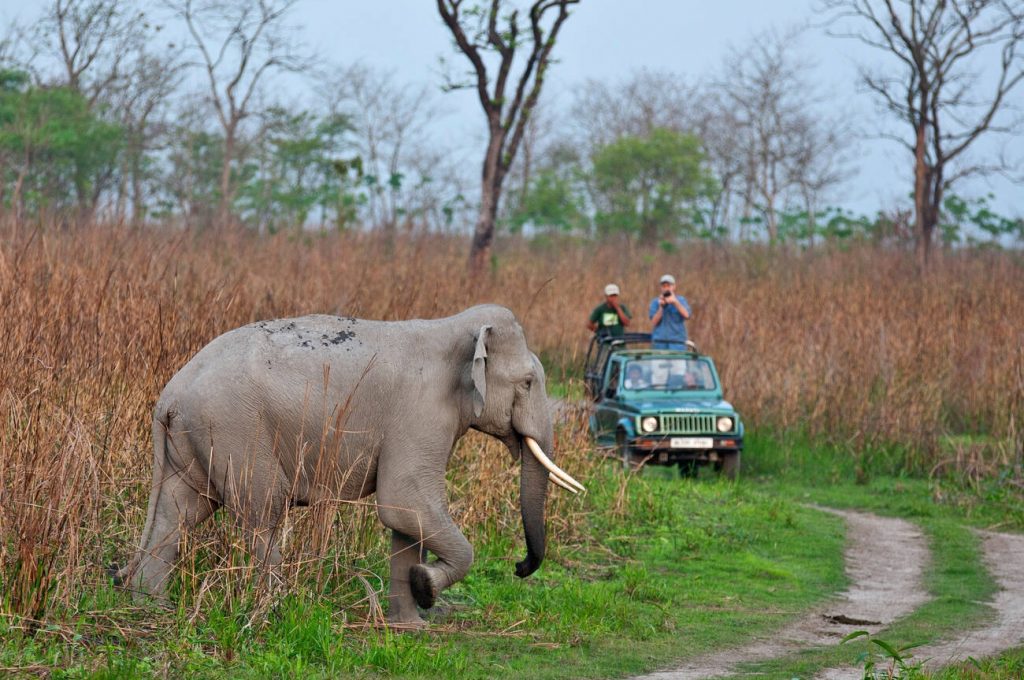
In the summer months of February to May, the temperature ranges from 7°C to 37°C, making it the best time to visit Kaziranga national park if you enjoy warm weather. This is also the time when the park is at its driest, making it easier to explore the area on foot or by jeep. During these months, the grass is shorter and animals can be more easily spotted. Additionally, the park’s beautiful landscapes and water bodies are best seen in the clear and bright sunlight of summer.
On the other hand, the monsoon season in Kaziranga National Park lasts from June to October, with temperatures ranging from 10°C to 35°C. Although the heavy rainfall can make the park’s roads and paths difficult to navigate, the monsoon season also offers a unique experience. The lush green landscape is an absolute delight to watch and the park’s numerous water bodies are at their best during this season. The monsoon season also brings with it an abundance of wildlife, as the animals come out in search of food and water. This makes it an excellent time to spot the one-horned rhinoceros and elephants, as well as various bird species and making it the best time to visit Kaziranga National Park. However, the safaris inside the jungle remain closed.
In winters, the park attracts a large number of migratory birds and the one-horned rhinoceros, which are native to the area. The winter season also offers ideal weather conditions for wildlife viewing and photography. Visitors can go on elephant and jeep safaris to spot the park’s diverse flora and fauna, including tigers, elephants, and various species of deer. Overall, Kaziranga in winter is a wonderful experience for nature lovers.
Regardless of the season, Kaziranga National Park is a place of great natural beauty and a must-visit destination for anyone interested in wildlife and nature. Whether you are a seasoned wildlife enthusiast or a first-time visitor, the park has something to offer for everyone. The best way to explore Kaziranga is by taking a guided tour, as the knowledgeable guides will be able to provide insights into the park’s flora and fauna, as well as its history and culture.
The best time to visit Kaziranga National Park depends on your preferences and the type of experience you are looking for. If you enjoy warm weather and clear skies, the summer months of February to May are the best time to visit. On the other hand, if you prefer a more lush and green landscape, the monsoon season of June to October is the ideal time to visit. Regardless of when you visit, Kaziranga National Park is sure to leave a lasting impression on you and is a must-visit destination for anyone interested in wildlife and nature.
Few things to do in Kaziranga
Wildlife Safari
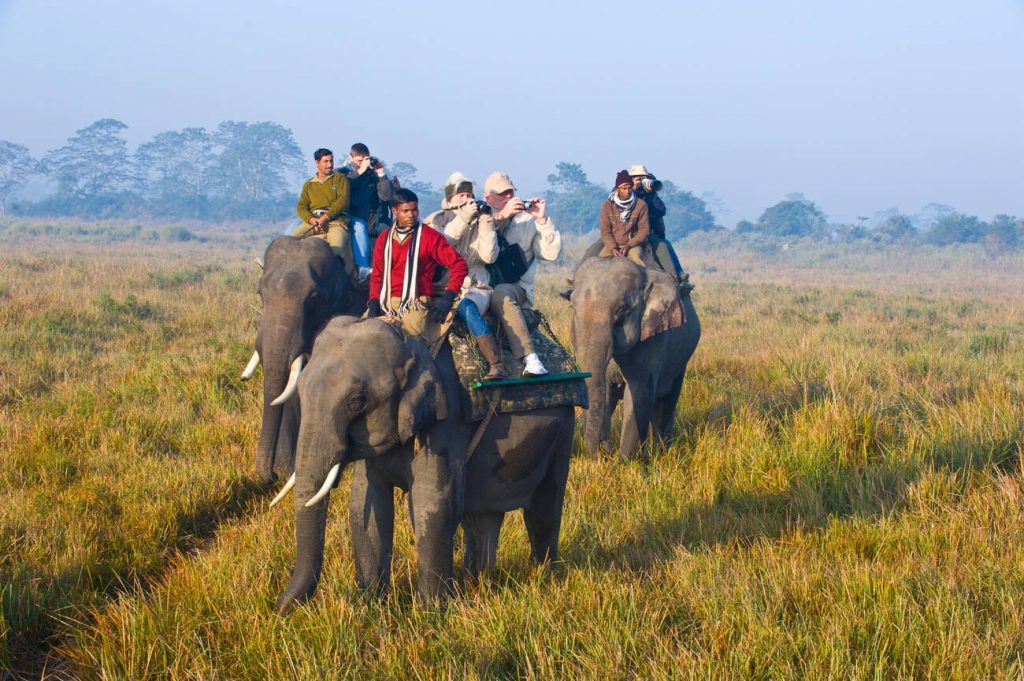
A wildlife safari is a must-do activity in Kaziranga to see the one-horned rhinos and other animals like elephants, tigers, and various species of birds and check and try the interesting Kaziranga National Park Safari.
Birds watching

Kaziranga is a bird-watcher’s paradise with more than 400 species of birds, including the Bengal florican, greater adjutant stork, and Pallas’s fish eagle.
Cultural tour
Assam is rich in culture and history, and visitors can take a cultural tour to see the local villages and learn about the traditional way of life of the people.
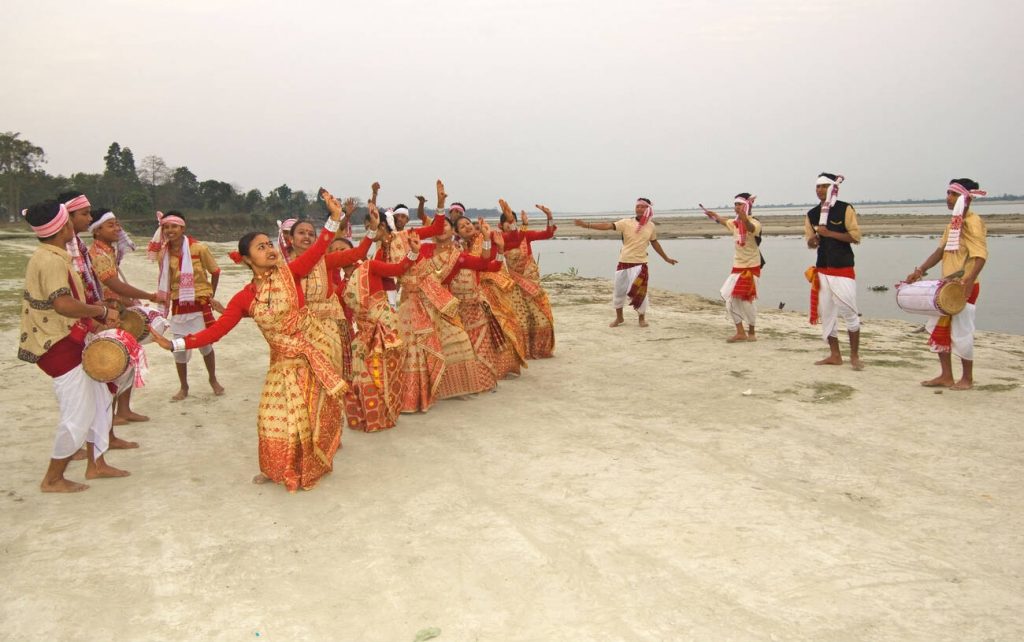
Tea plantation visit
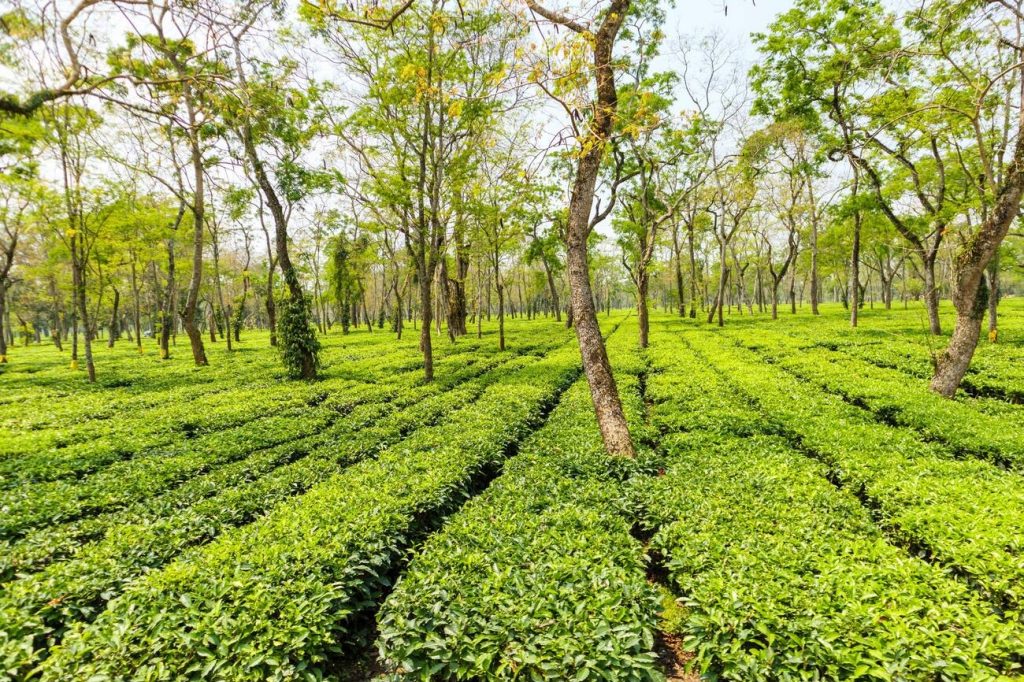
Tea plantations surround Kaziranga, and visitors can tour a tea factory to see how tea is processed and learn about the tea-making process.
Visit the nearby national parks and wildlife sanctuaries
Nearby national parks and wildlife sanctuaries like Manas National Park and Orang National Park offer opportunities for further wildlife viewing and exploration of the region.
cultural dance
The park is a great place to relax, recharge, and rejuvenate while enjoying the beauty of nature. Kaziranga National Park offers a wealth of experiences for visitors, whether they are interested in wildlife, nature, culture, or photography. With so many different options to choose from, visitors are sure to have an unforgettable time in this beautiful and diverse park. Following best time to Kaziranga National Park makes it a must-visit destination for nature lovers, wildlife enthusiasts, and anyone interested in learning about the rich biodiversity of northeastern India. With its diverse flora and fauna, breathtaking scenery, and opportunities for adventure, Kaziranga is an unforgettable destination that should not be missed. If you’re an avid birdwatcher, a nature lover, or simply looking for an adventure, Kaziranga has something to offer everyone.
How To Reach Kaziranga National Park?
Kaziranga National Park, situated about 200 kilometers from Guwahati, Assam (approximately 5 hours by road), spans across latitudes 26°30′ N to 26°45′ N and longitudes 93°08′ E to 93°36′ E. This extensive wildlife reserve covers parts of the Nagaon and Golaghat districts in Assam, specifically the Kaliabor subdivision in Nagaon and the Bokakhat subdivision in Golaghat.
The park encompasses a diverse landscape, characterized by fertile alluvial soil formed by Brahmaputra’s erosion and sedimentation processes. It features vast sandbars, riverline flood-formed lakes called ‘Beels,’ and elevated areas that serve as sanctuaries for wildlife during floods. Kaziranga is renowned for its remarkable biodiversity and is considered a Biodiversity Hotspot due to the presence of a wide variety of species.
Kaziranga National Park is located within the Indomalaya ecozone and primarily falls within the Brahmaputra Valley semi-evergreen forests, a subtype of the tropical and subtropical moist broadleaf forests biome. Additionally, it encompasses a frequently flooded variant of the Teral-Duar savanna and grasslands, which belong to the tropical and subtropical grasslands, savannas, and shrublands biome.
This extensive floodplain, nestled along the Brahmaputra River’s southern bank, forms the heart of the park. Kaziranga falls within the Indo-Burman Bio-geographical region. The park has expanded to cover approximately 429 square kilometers, offering crucial habitat for the growing wildlife population and establishing safe passages for animals to reach the Karbi Anglong Hills during periods of flooding.
Kaziranga National Park’s boundaries are naturally defined by the Brahmaputra River to the east and north, while the Mora Diphlu River forms its southern limit. To the south, National Highway-37 is considered the park’s boundary. The park’s headquarters are located in Bokakhat, Golaghat district, Assam.
FAQ
-
What is Kaziranga National Park Famous For?
Kaziranga National Park is a protected area located in the state of Assam in India. It is known for its diverse wildlife, particularly the Indian one-horned rhinoceros. The park is also home to elephants, tigers, wild water buffalo, and numerous bird species.
-
When is the best time to visit Kaziranga National Park?
The best time to visit Kaziranga National Park is from November to April. During this time, the weather is dry and cool, which makes it easier to spot wildlife. However, the park is closed during the monsoon season (May to October) due to flooding.
-
How can I reach Kaziranga National Park?
The nearest airport to Kaziranga National Park is in Jorhat, which is about 97 kilometers away. Guwahati is the nearest major city, which is about 217 kilometers away.
-
Are safaris available in Kaziranga National Park?
Yes, safaris are available in Kaziranga National Park. Jeep safaris are the most popular way to explore the park, with both morning and afternoon tours available. Elephant safaris are also available, but these are limited and must be booked in advance.
-
What are the entry fees for Kaziranga National Park?
The entry fees for Kaziranga National Park vary depending on the season and the type of safari you choose.




I’m new to your blog and i really appreciate the nice posts and great layout.*,”-’